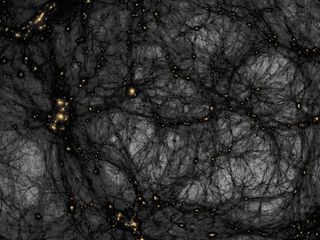
China is entering the race to detect mysterious dark matter in a big way, with a huge facility in Sichuan province set to begin collecting data in the coming weeks.
The $8 million PandaX (Particle and Astrophysical Xenon) experiment — which lies 7,874 feet (2,400 meters) underground, inside a mountain made of marble — will be up and running early this year, IEEE Spectrum reported recently on Discovery News. When it comes online, PandaX will join the world's other subterranean dark-matter experiments, such as the XENON project in Italy and the Large Underground Xenon (LUX) effort in South Dakota.
These experiments work on the same principle. They're looking for particles emitted when weakly interacting massive particles (WIMPS) — the postulated major component of dark matter, which is thought to make up more than 80 percent of all matter in the universe — collide with the nuclei of "normal" atoms inside a big tank of liquid xenon. PandaX and the other projects need to be underground, where they're shielded from most of the cosmic radiation that could generate similar signals.
The first science results are expected from PandaX by the end of the year, IEEE Spectrum reported. If everything works as planned, the project may be scaled up, employing a bigger tank of xenon to increase the chances of detection.
Read the full story at Discovery News here.
Follow Mike Wall on Twitter @michaeldwall and Google+. Follow us @Spacedotcom, Facebook or Google+.
Get the Space.com Newsletter
Breaking space news, the latest updates on rocket launches, skywatching events and more!
Join our Space Forums to keep talking space on the latest missions, night sky and more! And if you have a news tip, correction or comment, let us know at: community@space.com.

Michael Wall is a Senior Space Writer with Space.com and joined the team in 2010. He primarily covers exoplanets, spaceflight and military space, but has been known to dabble in the space art beat. His book about the search for alien life, "Out There," was published on Nov. 13, 2018. Before becoming a science writer, Michael worked as a herpetologist and wildlife biologist. He has a Ph.D. in evolutionary biology from the University of Sydney, Australia, a bachelor's degree from the University of Arizona, and a graduate certificate in science writing from the University of California, Santa Cruz. To find out what his latest project is, you can follow Michael on Twitter.

